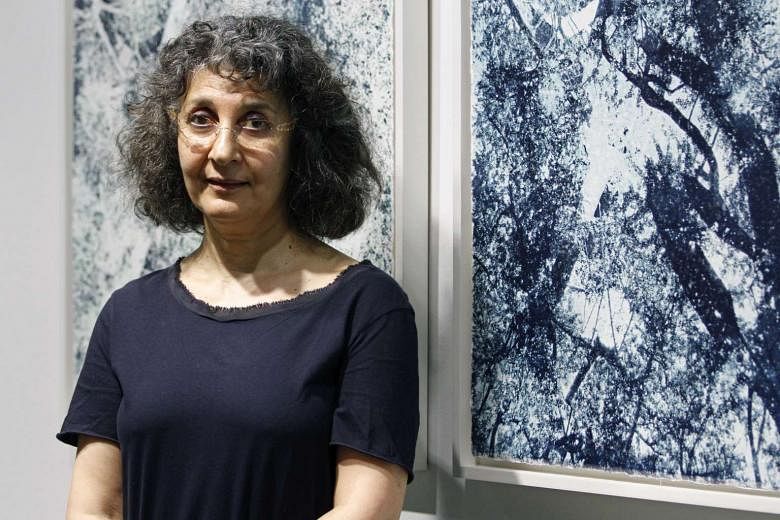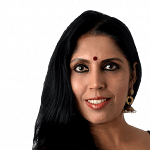The starting point for Shirazeh Houshiary's installation is complete darkness and that is how the Iran-born, London-based artist wants to introduce her art to viewers here.
Called Breath, the installation is part of The River Is Within Us, her South-east Asia debut solo, at STPI .
The installation was featured at the 2013 Venice Biennale and has made international news.
Speaking through the dark space, she says: "As an artist, I have always wanted to push the boundaries of new spaces. I want you to experience this first as it connects very strongly to the space and establishes a dialogue with the work I have created at STPI."
Inside Breath, time slows down. The eyes adjust to the absolute darkness and, in the moments of stillness that follow, people might find themselves tuning into the sound of four vocalists chanting Jewish, Christian, Buddhist and Islamic prayers. Visuals appear on the four video screens, expanding and contracting with the flow of the chants.
"The River Is Within Us is completely connected to Breath," the artist says, stepping back into the light of the gallery. "This whole idea of co-existence is something I have explored through my art. We have so much misunderstanding in our world today and a lot of that misunderstanding is because of our own lack of dialogue."
-
VIEW IT / THE RIVER IS WITHIN US: SHIRAZEH HOUSHIARY
-
WHEN: Till May 7. 10am to 7pm (Monday to Friday), 9am to 6pm (Saturday).
WHERE: STPI, 41 Robertson Quay
ADMISSION: Free
INFO: www.stpi.com.sg
Over many years of her artistic practice, Houshiary has addressed that by creating art that is deeply meditative.
The 13 print works she created during her residency at STPI are no different. In deeply layered pieces that invite a closer examination, people get to see the intense textual patterns that have long defined her art. Embedded in colourful backlit paper works are words drawn in Latin, Arabic, Hebrew, Chinese and Sanskrit.
Each word she has picked is "a revered word".
"These are words that we keep going back to, words that are often viewed as the seed of language," she says.
Om, for instance, is part of mediaeval era iconography. The word, found in many manuscripts, has associations with several religions, including Hinduism, Buddhism and Jainism and is widely used today as part of meditation and yoga.
"I wanted to go back to these words. The chance to work with paper got me thinking about many things. Paper or papyrus has long been the preserver of words and words are about our future as well," says the 61-year-old, who is married to British architect Pip Horne.
Another recurring theme in her work is the issue of migration.
Born in Shiraz in Iran, Houshiary left her country after the 1979 revolution which topped the Shah and established an Islamic republic. She went on to study art at the Chelsea School of Art in London and has returned to Iran only twice. As a permanent outsider, she understands the issues of identity and longing.
When she arrived in Singapore for the first time last year, she was completely taken by raintrees, which she soon found out were indigenous to Peru and Mexico.
"There was a story of migration right here. As an immigrant, I am fascinated by these stories. Migration is not something we should be afraid of, it is something to be celebrated," she says.
In her print works, the issue is addressed through pieces that draw on positives and negatives, light and shadows to create a complex, charcoal-like web. The effect is achieved by using several pigments on paper. These are among the 13 works she created here.
Together with Breath, there are 14 artworks on show. They are priced from $35,000 to $775,000 each.
She says: "There are positives and negatives in everything. Sometimes, it boils down to perceptions. I started by photographing these trees before turning them into print works."
The ease, depth and calmness with which she speaks about hot-button issues makes her art even more appealing.
She started as a sculptor and moved into painting and multi- media installations much later. In the 1980s, she was linked to the New British Sculptors, a group that included prominent names such as Anish Kapoor and Richard Deacon.
Her art is collected by museums including the Tate in London, the Museum of Modern Art and the Guggenheim in New York. A Turner Prize nominee in 1994, she has also had several solo shows presented by the Lisson Gallery in London and Lehmann Maupin in New York.
The varied influences on her art are best seen in her print works, which seamlessly bring together the many strands of her rich artistic oeuvre. They are indeed, as she says herself, "very emotionally charged".


